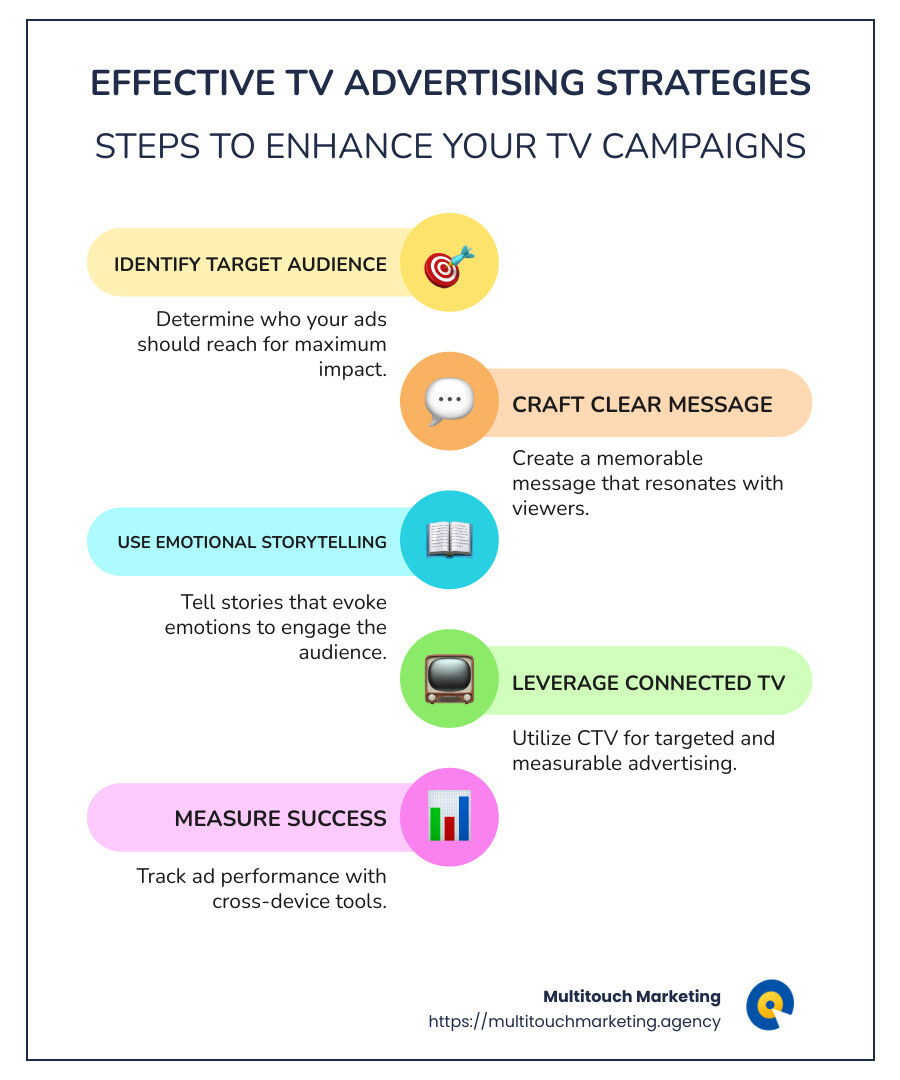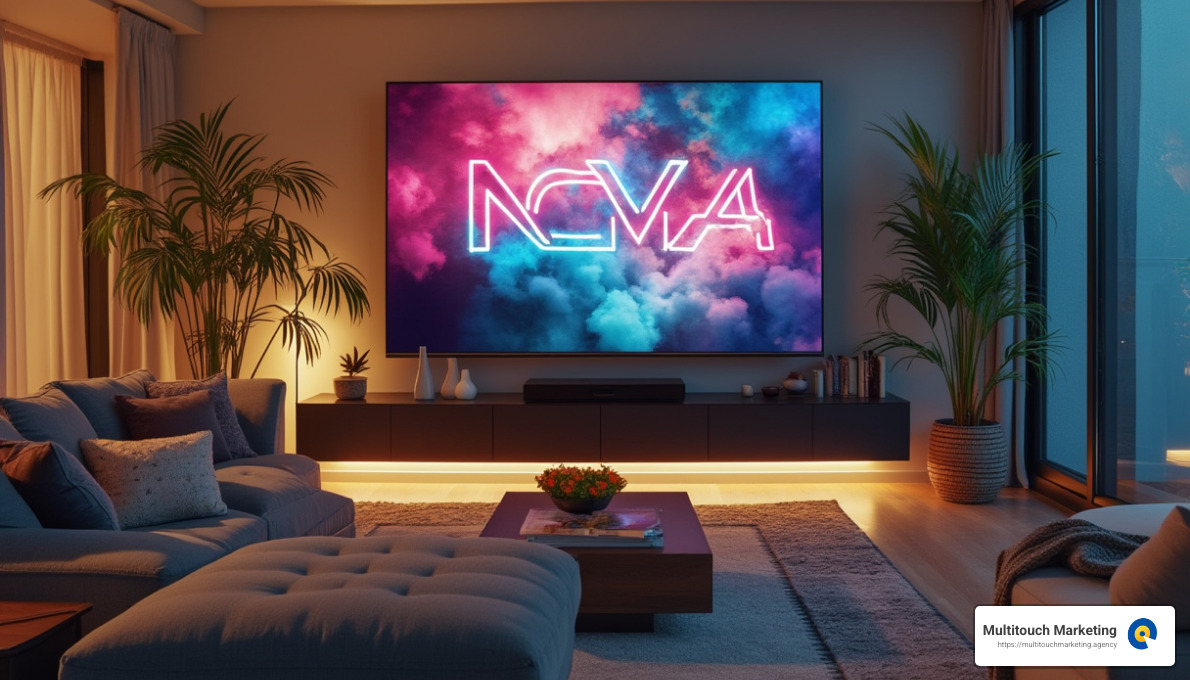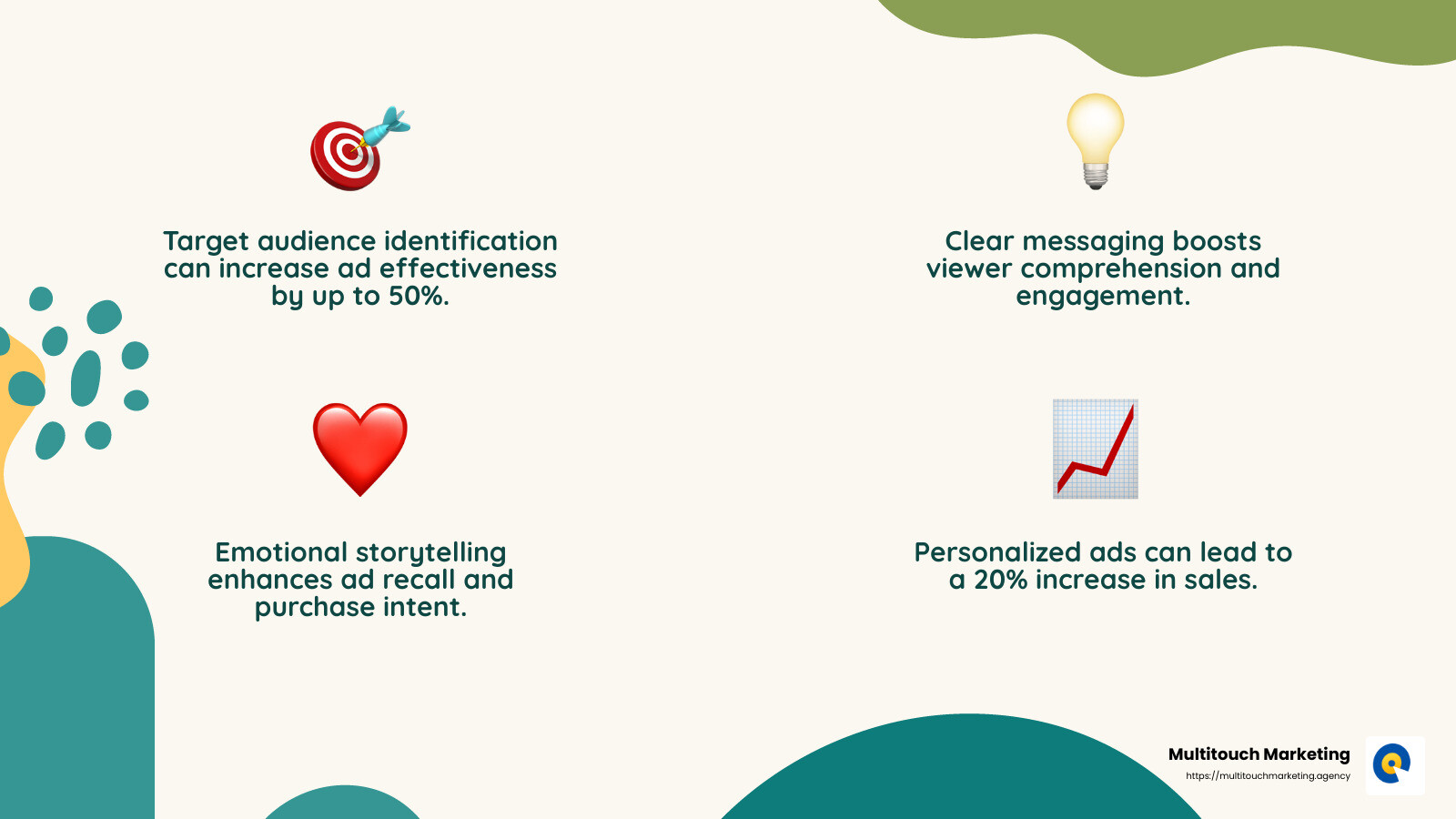Effective TV advertising strategies: Top 5 Proven Tactics
Effective TV advertising strategies have long been a cornerstone for building brand awareness and driving customer engagement. When digital platforms dominate, TV advertising still holds its ground by reaching broad audiences with emotionally resonant messages. Brands that implement successful TV ad strategies can inspire action through engaging storytelling and precise targeting.
Quick answer:
- Identify your target audience for precise ad placement
- Craft a clear, memorable message that speaks to viewer needs
- Use emotional storytelling to connect with audiences
- Leverage modern platforms like Connected TV for targeted reach
- Measure success with cross-device tools to track conversions
As you dive into these strategies, TV advertising remains a powerful tool, blending the reach of traditional platforms with the precision of digital techniques.
I’m Milton Brown, an expert in digital marketing with experience in crafting effective TV advertising strategies. From working with diverse industries to managing substantial marketing budgets, I’ve helped brands leverage TV advertising to boost visibility and drive business growth.

Understanding Effective TV Advertising Strategies
Creating effective TV advertising strategies starts with understanding your target audience, crafting a clear message, and utilizing emotional storytelling. These elements are crucial for connecting with viewers and inspiring action.
Target Audience
Identifying your target audience is the first step. Knowing who you’re talking to allows you to tailor your ads to their interests, values, and needs. Use tools like audience analytics and social media insights to gather data about your audience. This data helps you create detailed viewer personas, which guide your ad content and placement.
For example, if your audience values sustainability, highlight eco-friendly features in your product. This approach ensures your message resonates and encourages engagement.
Clear Message
A clear and memorable message is essential. Your ad should quickly convey the benefits of your product or service. Focus on how it solves a problem or fulfills a need.
Consider a campaign that combines personalization with a simple, clear message, driving engagement and sales.
To craft your message, emphasize unique advantages and use concise, persuasive language. This clarity helps your audience understand the value you offer, making them more likely to take action.
Emotional Storytelling
Emotional storytelling can transform your ad from ordinary to unforgettable. By weaving a narrative that touches the heart, you create a deeper connection with your audience.
Take an ad that tells a heartfelt story of love and loss. This demonstrates how emotional storytelling can increase brand recall and foster loyalty.
Incorporate emotions that align with your brand’s voice and values. Whether it’s humor, nostalgia, or inspiration, the right emotional appeal can make your ad stand out and resonate with viewers.
By focusing on these elements—target audience, clear messaging, and emotional storytelling—you can develop TV ads that effectively engage and convert. Dive into the next section to explore the differences between linear and connected TV advertising, and how to leverage each for maximum impact.
Linear vs. Connected TV Advertising
In television advertising, understanding the distinction between linear TV and Connected TV (CTV) is crucial for crafting effective strategies. Both offer unique advantages, and knowing how to leverage each can significantly impact your advertising success.
Linear TV
Linear TV refers to traditional television programming that is broadcast on a set schedule. Viewers tune in at specific times to catch their favorite shows or news. Advertisers purchase ad spots based on these schedules, often targeting broad demographics.
Pros of Linear TV:
- Credibility: TV ads lend credibility to brands, with 78% of millennials and Gen Zers associating TV advertising with brand trust.
Cons of Linear TV:
-
Limited Targeting: Unlike digital platforms, linear TV offers less precise targeting options. Ads are generally aimed at broad audience segments.
-
Measurement Challenges: Tracking the effectiveness of TV ads can be difficult, with fewer real-time analytics available compared to digital channels.
Connected TV
Connected TV (CTV) represents a modern approach to TV advertising. It includes streaming services and platforms like Hulu and Roku, delivering content via the internet. This method allows for more precise targeting and measurement.
Pros of Connected TV:
-
Advanced Targeting: CTV uses data-driven insights to target specific demographics, interests, and behaviors, similar to digital advertising.
-
Real-Time Analytics: Advertisers can track campaign performance in real time, making it easier to adjust strategies for better results.
Cons of Connected TV:
-
Fragmented Audience: With countless streaming platforms available, reaching a large audience may require advertising across multiple services.
-
Ad Avoidance: Some viewers may use ad-blocking features or opt for ad-free subscriptions, reducing potential reach.
OTT Platforms
Over-the-top (OTT) platforms deliver content directly to viewers over the internet, bypassing traditional cable or satellite providers. This includes streaming services like Netflix and Disney+.
Key Benefits of OTT:
-
Flexibility: OTT allows viewers to watch content on various devices, including smart TVs, tablets, and smartphones.
-
Interactive Features: Some platforms offer interactive ads, enabling viewers to engage with content, such as scanning QR codes or clicking on-screen prompts.
In conclusion, both linear and Connected TV advertising have their place in a comprehensive TV ad strategy. By understanding the strengths and limitations of each, you can tailor your approach to maximize reach, engagement, and conversion. Next, we’ll explore how to craft compelling TV ads that captivate and convert.
Crafting Compelling TV Ads
Creating compelling TV ads is both an art and a science. To capture attention and drive action, focus on three key elements: visual appeal, storytelling, and a clear call to action.
Visual Appeal
Visual appeal is crucial in television advertising. It grabs the viewer’s attention and communicates your brand’s message effectively.
-
Use Colors and Imagery Wisely: Choose colors and imagery that align with your brand. A cohesive visual experience makes your ad memorable and reinforces brand identity.
-
High-Quality Production: Even on a budget, clean and well-executed visuals can make a strong impact. Creative approaches can often outshine high production costs.
Storytelling
Storytelling in TV ads creates an emotional connection with viewers, enhancing brand recall and purchase intent.
-
Emotional Narratives: Emotional storytelling can resonate deeply with audiences. The narrative should evoke emotions that align with your brand values.
-
Humor and Relatability: Using humor in storytelling can engage viewers. Humorous and relatable stories can make your brand more likable.
Call to Action
A clear call to action (CTA) is essential for guiding viewers toward a desired outcome.
-
Be Direct and Compelling: Whether it’s visiting a website or trying a product, your CTA should be easy to understand and compelling enough to motivate action.
-
Measure Effectiveness: A strong CTA not only increases the likelihood of viewer response but also helps in measuring the ad’s effectiveness. Offer promotions or use persuasive language to improve your CTA’s impact.
By combining visual appeal, storytelling, and a clear call to action, you can craft TV ads that not only captivate but also convert. Next, we’ll dig into how to measure TV ad performance effectively.
Measuring TV Ad Performance
Measuring the performance of TV ads is crucial for understanding their impact and optimizing future campaigns. Let’s explore the key metrics and methods for evaluating the success of your TV advertising efforts.
Ad Metrics
Ad metrics provide valuable insights into how well your TV ads are performing. Here are some essential metrics to consider:
-
Reach: This metric tells you how many unique viewers saw your ad. It’s a vital indicator of your ad’s potential to build brand awareness.
-
Frequency: Frequency measures how often your target audience sees your ad. While it’s important for viewers to see your ad multiple times, too much exposure can lead to ad fatigue. Finding the right balance is key.
-
Impressions: Impressions count the total number of times your ad is viewed. While high impressions can indicate a successful campaign, it’s important to focus on how these impressions translate into engagement and action.
Viewer Engagement
Understanding viewer engagement helps you gauge how well your ad resonates with your audience. Here are some ways to measure engagement:
-
Website Visits: Track spikes in website traffic following your ad’s airtime. A significant increase suggests that your ad piqued viewers’ interest.
-
App Installs: If your ad promotes an app, monitor install rates after the ad airs. This correlation can indicate the ad’s effectiveness in driving action.
-
Social Media Interaction: Look for increased activity on social media platforms, such as likes, shares, and comments, after your ad airs. This activity reflects viewer engagement and can extend your ad’s reach.
Conversion Rates
Conversion rates reveal how effectively your TV ad drives desired actions, such as purchases or sign-ups. Here are some methods to measure conversions:
-
Sales Lift: Compare sales data before and after your ad campaign to identify any positive lift. While not as direct as online ads, TV ads can still drive significant sales increases.
-
Lower-Funnel Events: Track lower-funnel conversions, like shopping cart purchases, by tying them to upper-funnel events such as website visits. This method provides a more comprehensive view of your ad’s impact.
By analyzing these metrics, you can gain a deeper understanding of your ad’s performance and make informed decisions to improve future campaigns. Up next, we’ll address frequently asked questions about effective TV advertising strategies.
Frequently Asked Questions about Effective TV Advertising Strategies
What makes a TV ad effective?
An effective TV ad delivers a clear message and connects with viewers on an emotional level. A clear message ensures that your audience understands what your ad is about and what action you want them to take. Simplicity is key—avoid clutter and focus on one main idea.
Emotional pull is equally important. Ads that evoke feelings—whether it’s laughter, nostalgia, or empathy—tend to be more memorable. Campaigns that use humor and relatable scenarios can create a lasting impression.
How much does a 30-second TV ad cost?
The cost of a 30-second TV ad varies widely. Several factors influence the price:
- Airtime: Prime time slots (evenings) are more expensive than daytime slots. Special events can command astronomical rates.
- Audience Size: Ads airing on channels with larger audiences generally cost more. For instance, a spot on a major network will be pricier than one on a niche cable channel.
- Ad Frequency: Running your ad multiple times increases the overall cost, but it can also improve reach and effectiveness.
While costs can range from a few thousand dollars to millions, the investment can be worthwhile given the broad reach of TV advertising.
What are the advantages of TV advertising?
TV advertising offers several advantages that make it a valuable part of a marketing strategy:
-
Broad Reach: TV ads can reach millions of viewers simultaneously, making it ideal for building brand awareness quickly.
-
Brand Credibility: Many consumers trust TV ads more than digital ads. According to Kantar, 78% of people trust TV ads, which is higher than trust in online and social media ads.
-
Emotional Connection: TV is a powerful medium for storytelling. It allows brands to create emotional connections through visual and auditory elements, enhancing viewer engagement.
Despite the rise of digital platforms, TV advertising remains a potent tool for reaching large audiences and building brand credibility. By understanding the costs and leveraging its strengths, businesses can craft effective TV advertising strategies that drive results.
Let’s Work Together
At Multitouch Marketing, we understand the power of effective TV advertising strategies. Even in this digital age, TV advertising holds a unique place in building brand awareness and driving customer engagement. Our expertise in digital marketing, especially in pay-per-click (PPC) advertising, allows us to blend traditional TV strategies with cutting-edge digital techniques for maximum impact.
TV advertising offers unparalleled reach and credibility, which are essential for any marketing campaign. When combined with our digital marketing prowess, the results can be transformative. We ensure that your ads are not just seen, but also remembered and acted upon. By crafting compelling narratives and leveraging emotional storytelling, we help brands connect with their audiences on a deeper level.
Our approach is data-driven. We use advanced metrics to measure ad performance, ensuring that your investment yields the best possible return. This commitment to analytics and optimization is what sets us apart.
Ready to improve your advertising strategy? Find how our digital marketing expertise can lift your brand. Learn more about our services.


